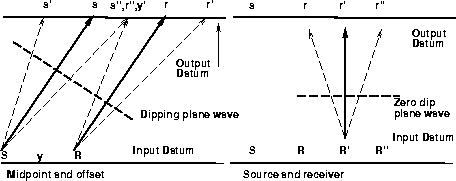 |
Figure 1 Datuming in midpoints and offsets antialiases with respect to dipping plane waves for nonzero midpoint dip. Datuming in source and receiver coordinates considers vertically propagating plane waves.
An operator is antialiased when crossing plane waves (hyperbola flanks) are orthogonal Claerbout (1995). Generally speaking, if the data are poorly sampled and contain many dips, the situation is hopeless, because the operator will either bandpass dipping events into oblivion or alias them. If some limiting assumption can be made about the dips present in the data, then whatever operator bandwidth is available can be centered around those dips, and more frequency preserved in the output.
In my proposed operator, datuming is performed in midpoint and offset coordinates. This has the considerable benefit that energy moves across crossline midpoints with high bandwidth, even when sampling is poor. Datuming in midpoint and offset coordinates still has the appearance of spraying hyperbolas with smoothed flanks. However, consideration of the traveltime paths (shown in Figure 1) shows that the largest bandwidth plane waves dip to propagate along midpoint dip, while the source and receiver datuming operator always has its maximum bandwidth traveling vertical. Projecting the traveltime paths into the subsurface suggests that many structural dips can be better upward continued by the midpoint and offset version of the operator.
Also, in midpoint and offset coordinates there are assumptions that can potentially be made about the time dips in the data, to further increase operator bandwidth. A principal time dip for antialiasing is chosen to correspond to source and receiver rays which converge at some depth. In the limiting case (also the easiest case and the one used here), the depth is infinite, the rays are parallel, and in common midpoint gathers the operator has maximum bandwidth predictably at its top. That can easily be tuned to some finite depth to favor a particular dataset; it could even be depth-variable. Depth-variable principle time dip would require a more costly time-domain operator, because the time dip used to compute the width of smoothing would be time-dependent, but might pay off with spectacular bandwidth.
 |